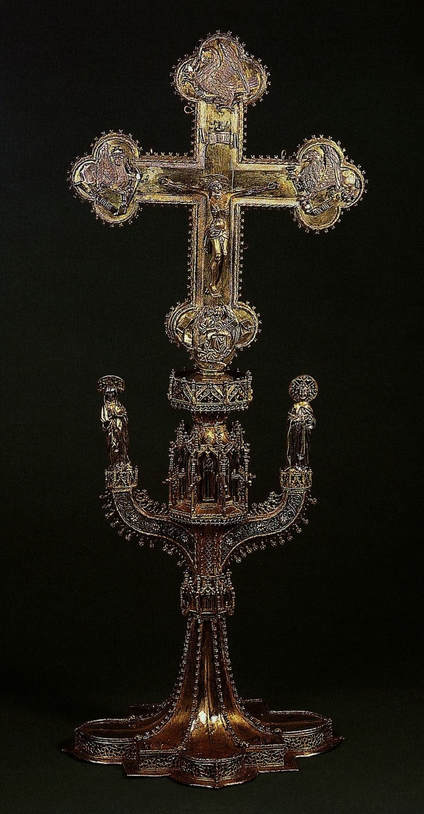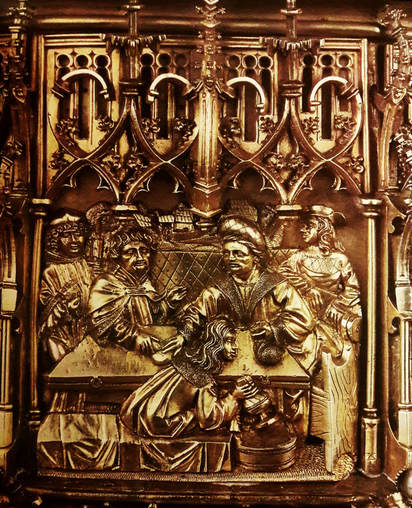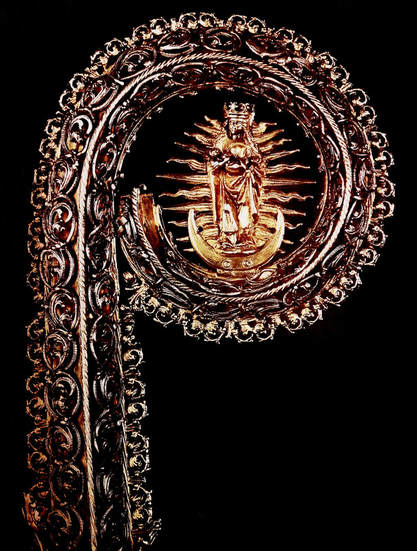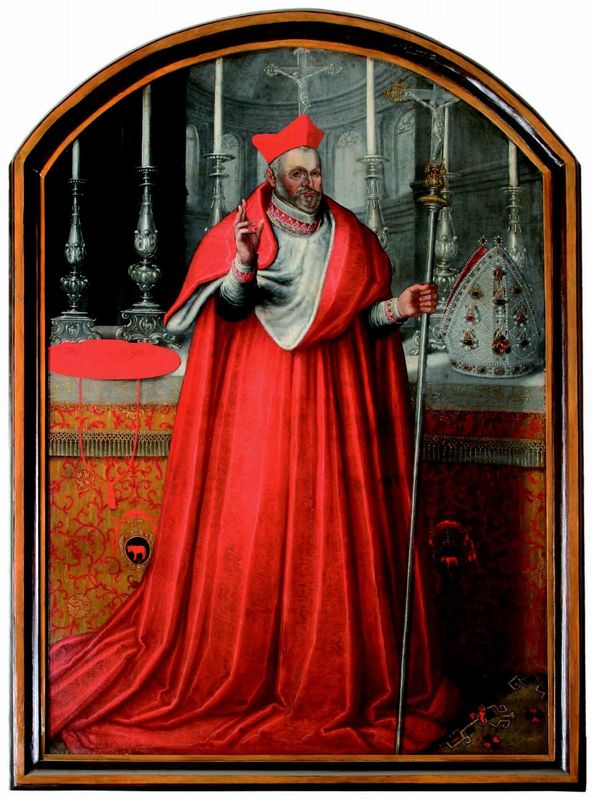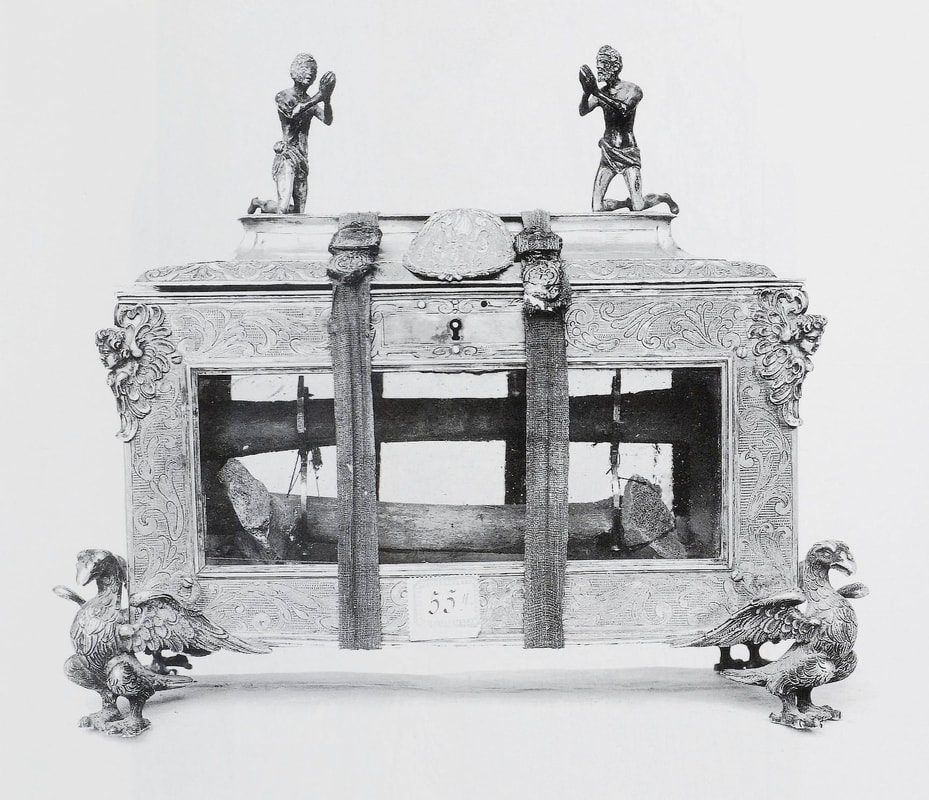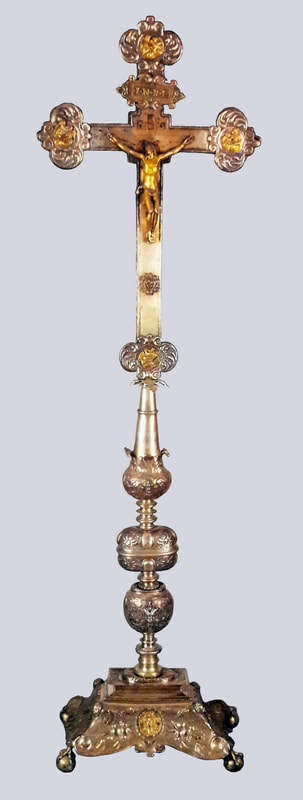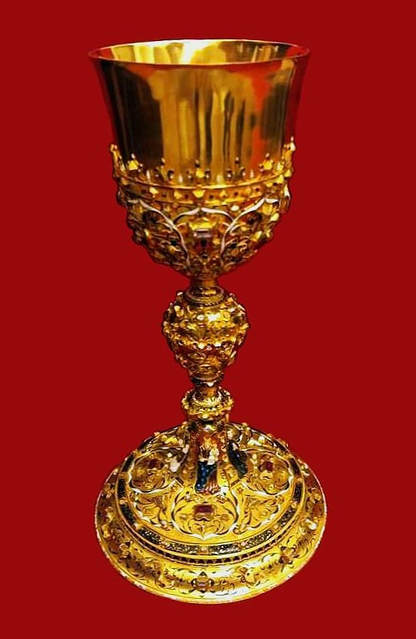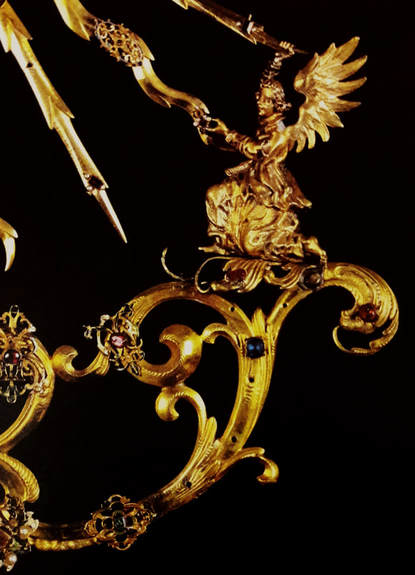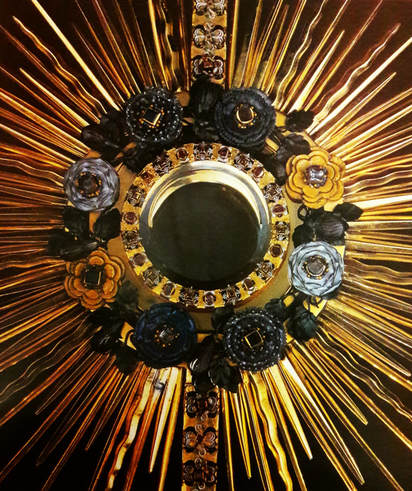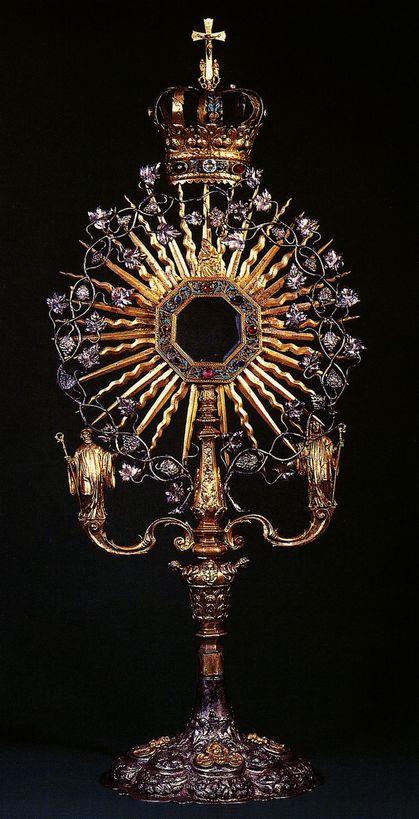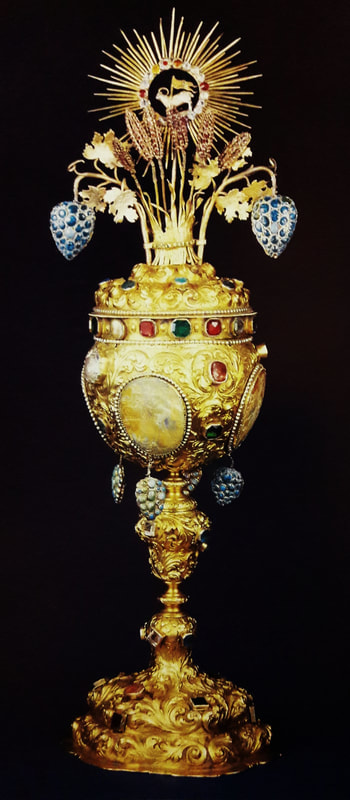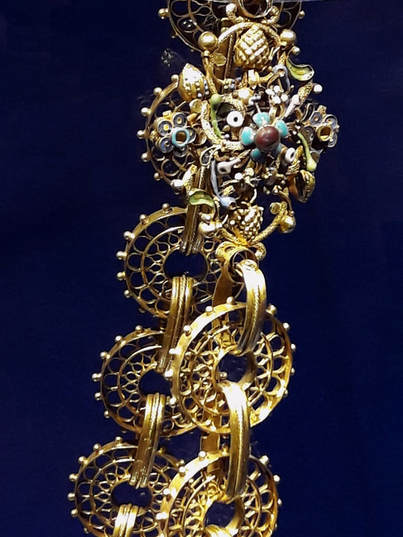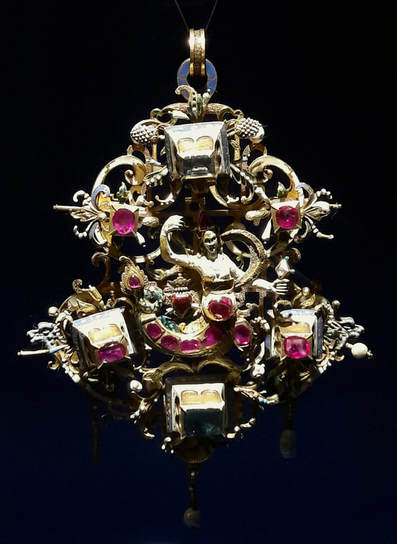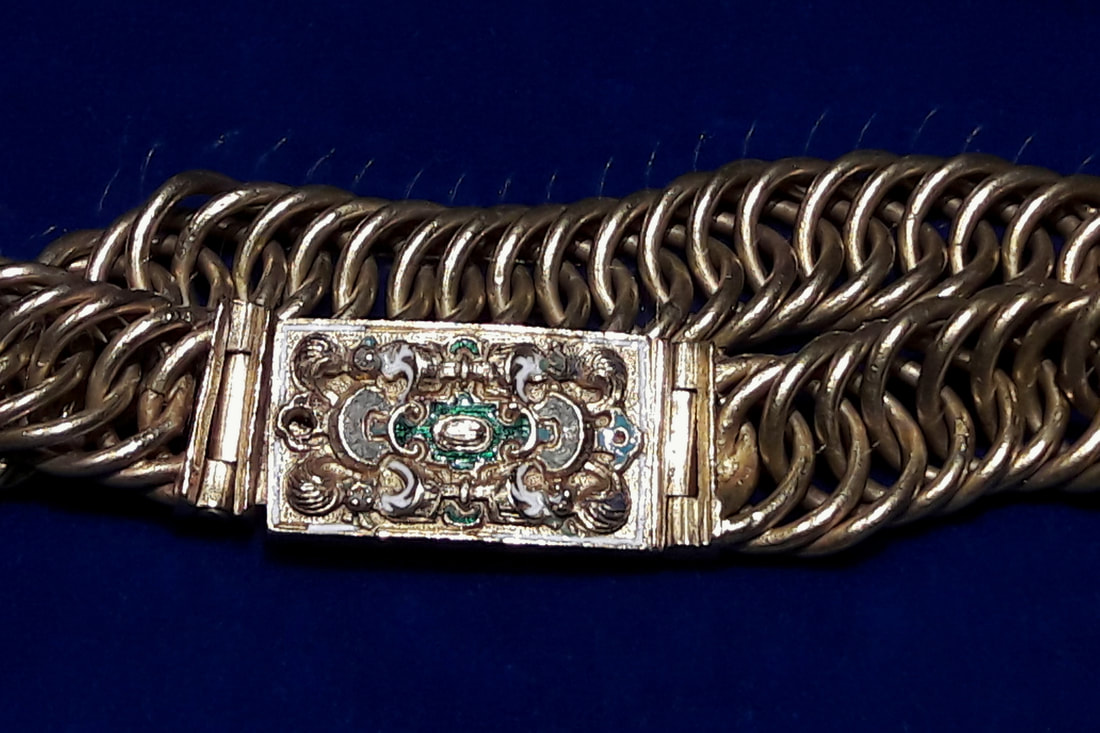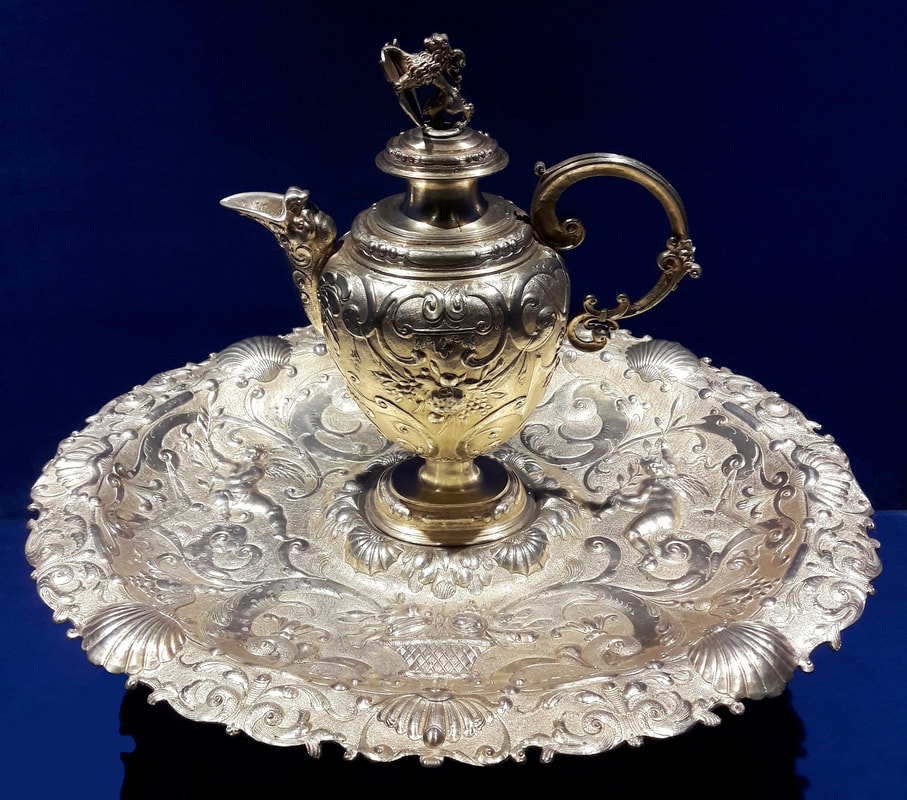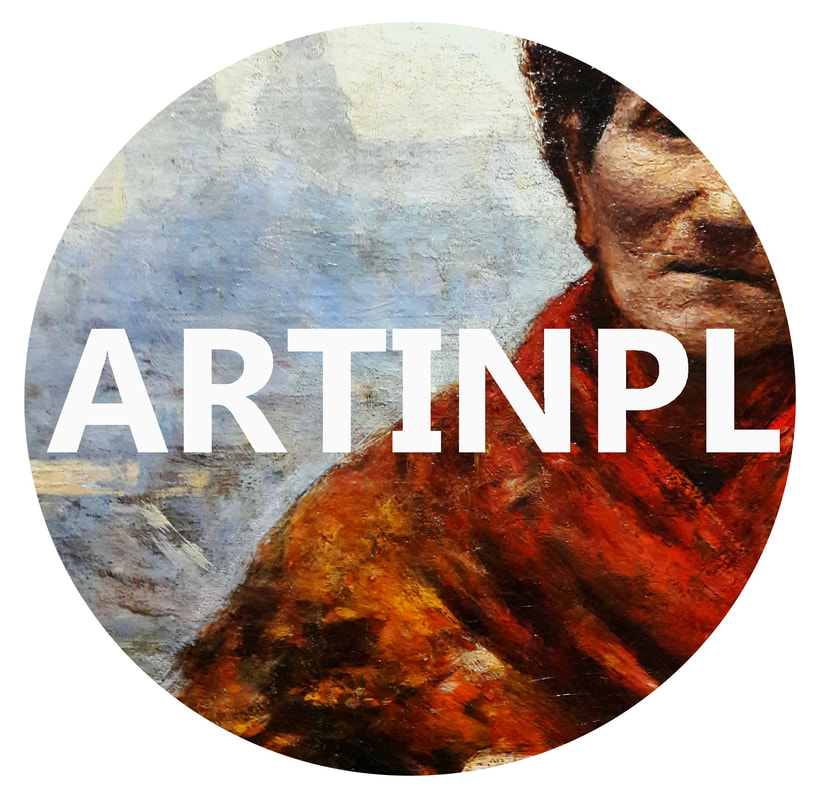|
Main religious centers of Poland were also main centers for religious craftemanship in the country. Kraków with its status of coronation city and largest city of southern Poland had an adantage over other locations with the largest number of goldsmiths. A diploma issued in 1478 by Jan Rzeszowski, Bishop of Kraków, Jakub Dembiński, castellan and starost of Kraków, Zejfreth, mayor of Kraków, Karniowski and Jan Theschnar, Kraków's concillors to Jan Gloger, son of Mikołaj Gloger, aurifaber (goldsmith) of Kraków, recognizes Jan as a man of good fame and worthy of admission to the guild of goldsmiths. The document confirms that church had a profound influence on development of this craftsmanship in the country.
Reliquary cross of Andrzej Nosek of Rawicz coat of arms, Abbot of the Tyniec Abbey by Anonymous from Kraków, ca. 1480, Cathedral Treasury in Tarnów.
Fragment of gold reliquary for the head of Saint Stanislaus with selling of a village by Marcin Marciniec, 1504, Cathedral Museum at Wawel Hill in Kraków.
Silver crosier of Bishop Andrzej Krzycki by Anonymous from Kraków, 1527-1535, Płock Cathedral.
Portrait of Primate Bernard Maciejowski (1548-1608) by Anonymous from Kraków, ca. 1606, Franciscan Monastery in Kraków. The Primate was depicted holding silver legate's cross against silver altar set commissioned by him before 1601 in Italy and with a 15th century jewelled mitre of cardinal Frederick Jagiellon.
Reliquary of Saint Stanislaus founded by Bishop Marcin Szyszkowski by Anonymous from Poland, ca. 1616-1621, Basilica of Saint Francis of Assisi.
Silver altar cross offered by Primate Wacław Leszczyński to the Gniezno Cathedral by Anonymous from Poland, first quarter of the 17th century, Archdiocesan Museum in Gniezno.
Gold chalice founded by Anna Alojza Chodkiewicz by Anonymous from Poland, ca. 1633, Treasury of the Lublin Archcathedral.
Fragment of a monstrance adorned with jewels from private donations by Anonymous from Lublin, ca. 1650, Dominican Monastery in Lublin.
Fragment of monstrance adorned with enamel by Anonymous from Poland, 1670s, Treasury of the Jasna Góra Monastery.
Monstrance with St. Benedict and St. Scholastica from the Tyniec Abbey by Anonymous from Lesser Poland, 1679, Cathedral Treasury in Tarnów.
Ciborium adorned with mother of pearl founded by guardian Stefan Opatkowski by Anonymous from Kraków, 1700, Franciscan Monastery in Kraków.
The invasion of the Polish-Lithuanian Commonwealth by neighbouring countries in the year of 1655 ended almost a century period of prosperity since the establishment of the noble republic in 1569. This war, one of the worst in country's history, and known as the Deluge (1655-1660), resulted in the loss of approximately 25% of the population in four core provinces, destruction of 188 cities and towns, 81 castles, and 136 churches. It had a profound impact on all aspects of life and future generations as well as on country's culture. Invasion and occupation by Lutherans from north and west (Sweden and Brandenburg), Calvinists from the south (Transylvania) and Orthodox from east and south (Russia, Wallachia and Moldavia) also significantly strengthened Catholics in previously multi-religious nation. The invaders were renowned for looting even marble flooring and church vestments. In 1658 Swedish troops of commander Pleitner murdered in the church in Skrwilno the local vicar, Father Walerian Cząpski for refusing to declare where he hidden "the treasure of the church".
In those circumstances, between 1655 and 1660, Zofia Magdalena Loka of Rogala coat of arms, owner of Okalewo estate and widow of Stanisław Piwo of Prawdzic coat of arms, deputy cup-bearer of Płock, hidden in the remains of the 11th century settlement in Skrwilno, her most valuable belongings. Discovered in 1961 in a shallow, approx. 50-cm excavation, were gold objects of more than 2 kg weigh, and silver objects of about 5 kg weigh. The treasure consist of the most exquist works of art including gold jewellery from the first half of the 17th century, like pendant with the figure of Fortune set with precious stones and coated with blue, white and green enamel, 6 chains including a chain set with precious stones made up of circular open work links and eight rosettes set with rubies and turquoises, 4 bracelets, two of them with clasps laid over with green, blue, or white enamel and the third coated with black enamel bearing the letters I.H.S. engraved amid the acanthus leaf motif, 16 żupan buttons of Stanisław Piwo, 5 gold and set with rubies, 5 with rock crystal, and 6 made of gilded silver. There is also a silver belt with imitation of encrusting, a silver filigree chain, a fragment of filigree gold chain with enamelled elements, 4 rings and 51 pearls. Silver tableware constitute the other part of the treasure. It includes silver lavabo set with Rogala coat of arms created by Balthasar Grill in Augsburg and commissioned by Jan Loka, starost of Borzechowo, father of Zofia, a pair of scissors for trimming candle wicks with Prawdzic coat of arms, two silver candlesticks made in Toruń and Brodnica, 12 silver spoons by Hans Nickel, William de Lassensy, Reinhold Sager and Hans Martelius, finest Toruń silversmiths of the time, and a tankard. Stanisław Piwo died on January 17, 1649 at the age of 53, hence before the invasion, and was buried in the Benedictine nuns Church in Sierpc, where his wife founded him a tomb monument in marble and alabaster depicting him kneeling before the crucified Christ. The tomb was most probably destroyed in 1655, when a Swedish troop looted the Benedictine Monsatery or in 1794 during the fire of the church. Zofia was 10 years younger then her husband and they were married for 26 years. Both Zofia nad Stanisław wer benefactors of many local churches - in 1644 Stanisław offered to the church in Sierpc a gold cloth chasuble and his wife in 1649 offered a silver plaque. In 1650, a year after death of her husband she offered a veil emboidered with gold thread for the image of Our Lady of Sierpc. She lived for few years in her large wooden manor in Okalewo and during the Deluge, she probably left for Gostynin. Nothing is known about her later years.
Gold chain set with precious stones of Zofia Magdalena Loka by Anonymous from Germany or Poland, ca. 1600, District Museum in Toruń.
Pendant with the figure of Fortune of Zofia Magdalena Loka by Anonymous from Transylvania or Poland, turn of the 16th and 17th century, District Museum in Toruń.
Bracelet with a stylized cartouche of Zofia Magdalena Loka by Anonymous from Poland, first quarter of the 17th century, District Museum in Toruń.
Silver lavabo set of Jan Loka, starost of Borzechowo by Balthasar Grill, 1615-1617, District Museum in Toruń.
|
Artinpl is individual, educational project to share knowledge about works of art nowadays and in the past in Poland.
If you like this project, please support it with any amount so it could develop. © Marcin Latka Categories
All
Archives
April 2023
|
